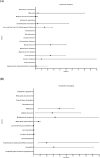Epidemiology and distribution of 207 rare diseases in China: A systematic literature review
- PMID: 38836174
- PMCID: PMC11145401
- DOI: 10.5582/irdr.2024.01001
Epidemiology and distribution of 207 rare diseases in China: A systematic literature review
Abstract
Epidemiological data on rare diseases in China are currently limited. The objective of this study was to provide a comprehensive understanding of the prevalence and incidence of rare diseases by systematically analyzing the available epidemiological data. We conducted a comprehensive search of English and Chinese databases, the Incidence and Prevalence Database, the Chinese Rare Disease Guideline, and the Taiwan Health Promotion Administration from 2010 to 2023. We identified the top diseases and regions based on epidemiological data and present the maximum, minimum, and median prevalence and incidence values in tables and forest plots. 1,264 prevalence and incidence data were retrieved from 277 studies, guidelines and official websites, covering 110 rare diseases (53.1%) and 32 regions (94.1%). In terms of geographical regions, incidence or prevalence data were available for 32 regions (94.1%), excluding Tibet Hui Autonomous Region and Macao Special Administrative Region. In terms of rate, 60 and 77 out of 207 diseases (29.0% and 37.2%) had available incidence and prevalence data, respectively. Eight diseases had an incidence rate equal to or greater than that of 1,000 patients per million. The present study provides a comprehensive epidemiological analysis and valuable insights into the prevalence and incidence of rare diseases in China. Our findings underscore the pressing need for sustained drug research and medical support for individuals and families impacted by rare diseases.
Keywords: China; epidemiology; rare disease.
2024, International Research and Cooperation Association for Bio & Socio - Sciences Advancement.
Conflict of interest statement
This work was supported by a grant from Innovation and entrepreneurship projects in Shanghai, China (S202210247117).The authors have no conflicts of interest to disclose.
Figures


Similar articles
-
[Bibliometric analysis of scientific articles on epidemiological study of burns in China].Zhonghua Shao Shang Za Zhi. 2017 Apr 20;33(4):233-237. doi: 10.3760/cma.j.issn.1009-2587.2017.04.009. Zhonghua Shao Shang Za Zhi. 2017. PMID: 28427137 Chinese.
-
A Systematic Review of Epidemiology and Risk Factors Associated With Chinese Inflammatory Bowel Disease.Front Med (Lausanne). 2018 Jun 19;5:183. doi: 10.3389/fmed.2018.00183. eCollection 2018. Front Med (Lausanne). 2018. PMID: 29971235 Free PMC article.
-
Incidence and prevalence of 121 rare diseases in China: Current status and challenges.Intractable Rare Dis Res. 2019 May;8(2):89-97. doi: 10.5582/irdr.2019.01066. Intractable Rare Dis Res. 2019. PMID: 31218158 Free PMC article. Review.
-
Public sector reforms and their impact on the level of corruption: A systematic review.Campbell Syst Rev. 2021 May 24;17(2):e1173. doi: 10.1002/cl2.1173. eCollection 2021 Jun. Campbell Syst Rev. 2021. PMID: 37131927 Free PMC article. Review.
-
The future of Cochrane Neonatal.Early Hum Dev. 2020 Nov;150:105191. doi: 10.1016/j.earlhumdev.2020.105191. Epub 2020 Sep 12. Early Hum Dev. 2020. PMID: 33036834
Cited by
-
A retrospective study of insurance coverage status and economic cost of rare diseases in Hainan Province.Sci Rep. 2025 Apr 17;15(1):13252. doi: 10.1038/s41598-025-97836-0. Sci Rep. 2025. PMID: 40247032 Free PMC article.
-
Traditional Chinese medicine for intractable and rare diseases: Research progress and future strategies.Intractable Rare Dis Res. 2025 May 31;14(2):109-121. doi: 10.5582/irdr.2025.01028. Intractable Rare Dis Res. 2025. PMID: 40485888 Free PMC article. Review.
References
-
- Li DG, Wang L, Xu XX. The revision of the definition of rare diseases in China from the perspective of clinical epidemiology. Journal of Clinical Pediatrics. 2021; 39:561-564. (in Chinese)
-
- Zhang AH. How to carry out clinical research on rare diseases. Proceedings of the 19th China-International Biophysics Congress. Hefei, Anhui, China, 2021. (in Chinese)
-
- Jun L, Xiang P. Comments on research status and future of rare diseases in China. China Tropical Medicine. 2023; 23:109-114. (in Chinese)
-
- Linkang L, Xueyi T. Present situation and prospect of diagnosis, treatment and guarantee of rare diseases in China. Chinese Journal of New Drugs and Clinical Remedies. 2023; 42:65-70, 60. (in Chinese)

